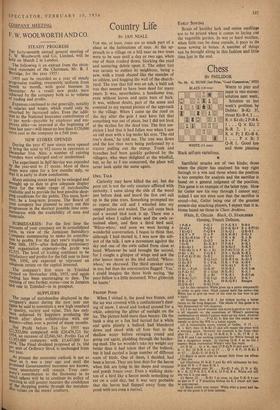Chess
BY PHILIDOR
No. 36. G. HUME (2nd Prize, 'Good Companions,' 1921) WHITE: (II men)
BLACK (14,men) WHrfE to play and
mate in two moves: solution next week.
Solution to last week's problem by Dobbs: B-Kt 3!, threat Kt-B 4. 1 ... R x Kt ch; 2 P-B 4.
1 . Q X Kt; 2 R-R 7. 1 . . . R x P; 2 Kt-B 6. I . . P x B; 2 Q-R 1. Good key and three pleasing
Black self-pin variations.
Sacrificial attacks are of two kinds; those where the player has analysed his way right through to a win and those where the position is too complex for analysis and the sacrifice is based on a general judgment of the position. This game is an example of the latter type. How far Geller saw his way through I cannot say; indeed 1 am not even sure that the sacrifice is sound—but, Geller being one of the greatest present-day attacking players, I expect that it is. Notes based on those in Chess Archives. White, E. GELLER Black, G. STAHLBERO Opening, French Defence.
I P-K 4 P-K 3 21 P-K B 3 B-B 4 2P-Q 4 P-Q 4 22 P-K Kt 4 B x B 1'? 3 Kt-Q 2 P-Q B 4 23 R-Q 2 Q W-B 1 4KP x P Q x P 24K R-B 1 B-Kt 3 5KKt-B3(a) PxP 25RxR RxR. 6 B-Q B 4 Q-Q3 26 Bx P P-R3
7 0-0 Kt K3 B 3 27 P-B 4 R-K 1
8 Kt-Kt 3 Kt-B 3 28 B-Kt 2 R-K S 9 Kt (Kt 3) x P Kt x Kt 29 P-Kt 5 (J) R x P 10 Kt x Kt P-Q R 3 20 B x Kt ch K-R
11 P-Q Kt 3! (b) Q-B 2 31 R-Q 8 B-Kt 8
12 Q-K 2 B-Q 3 (c) 32 R-R 8 ch K-Kt 3 13 Kt-B 5 B x P eh 33 R x Pch K-B 4 14 K-R 1 34 K-Kt 3 R-K 5
IS Kt x P (d) Q-- K 4? 35 R-R 2 R-K 6 ch
l6 P-Kt 311 Q x Q (e) 36 K-132 R-K 5 l7 B x Q K x Kt 37 R-R 1 R-B 5 eh
IA B-Kt 2(f ) P-K 4 (g) 38 K-Kt 3 B-K 5
19 K x B R-K 1 39 R-Q B 1 Resigns 20 Q R-Q I B-Kt 5?(h) (a) In this variation White gives up a pawn temporarily in order to gain time; Black cannot hold the Miwn—but White has to give up most of the time he has won to get it back! (b) Stronger than B-K 3, the bishop having a better future on the long diagonal. The whole of this game is in tact dominated by this diagonal.
(c) 1 do not know whether this move is good or not, sing it an depends on the soundness of White's answering combination on which 1 cannot make up my mind. Archives recommends 12 . . . P-Q Kt 4; first but this seems to me merely to drive the WB to a better square.
(d) A remarkable move, typical or Geller. If 15 . . .
K x Kt?; then 16 B-Kt 2! and will regain the piece with a winning game. However the position is far from clear after 15 . ' . kl-K 41 e.g. 16 B-11 6, B x R; 17 R x Q-B 41 and I see nothing conclusive for White though he has a dangerous attack. In playing Q-K 4 as he did 1 suspect Black overlooked White's very fine reply. (e) If 16 .. . Q x R; then 17 P-Q B 3! and now 17
K x Kt; 18 11-R 6 ch or 17 . . Q x B P; 18 B-Kt 2 or 17 . Q-Kt 8; 18 B-Q 3. (f) Black is never able to escape fully from the effects of this pin. (g) Otherwise 19 B-K 5 and Kt will ultimately be lost. If now 19 B x P then R-K 1. (h) He should play 20 . . . Kt-Kt 5 ch; 21 B X Kt, B x B; 22 P-K El 3, 11-1) 4; 23 P-K B 4. White will still win but it is less easy.
(i) Better 22 . . B-Kt 3 at once, so that P-K- B 4 can be met by P x P attacking bishop on K 2 which will than be unprotected. (I) Black could now resign: White wins a piece and tbo rest of the game is of link: interest.


































 Previous page
Previous page